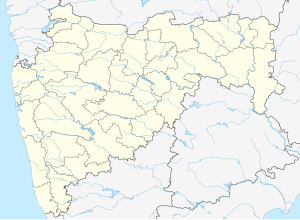| Kali Masjid | |
|---|---|
| Religion | |
| Affiliation | Islam |
| Leadership | Syed Farooque |
| Location | |
| Location | Jalna, Maharashtra |
| Country | India |
| Geographic coordinates | 19°50′25″N 75°52′35″E / 19.8403°N 75.8764°E |
| Architecture | |
| Type | Mosque |
| Style | Deccan Sultanate architecture |
| Date established | 1578[1] |
| Construction cost | Unknown |
| Specifications | |
| Capacity | 700 |
| Length | 40 metres (130 ft) |
| Width | 27 metres (89 ft) |
| Dome(s) | 1 |
| Minaret(s) | 4 |
| Minaret height | 20 metres (66 ft) |
| Materials | Red sandstone, Black Stone |
Kali Masjid, also known as Jumma Masjid, is a 16th-century mosque, known for its unique architectural features with black stones and rich cultural heritage.[2][3] It is located in Jalna, Jalna district of Maharashtra and attracts visitors from around the world.
History
[edit]The mosque was constructed in the year 1578, built by the reigning Nizam Shahi dynasty.[1] It is located in the middle of the old section of the city, Old Jalna, and is known as the black mosque, because it is constructed out of black stone. Approximately 700 people can pray at a time.[4][5][6] The stone used for the construction of the mosque and a large pond for water was needed, for this there was a stone-filled complex ground on the west side of the mosque, where Moti Talab was constructed and the stones of that area were cut and carved. was built[3]
Over time, the mosque has undergone various renovations, preserving its historical significance. Its well-preserved entrance door bears the date of construction in Persian, showcasing the remarkable craftsmanship of the era.[7]
Architecture
[edit]The Kali Masjid is located inside a rectangular walled compound, closed on three sides with an arcade in the front. The entrance is through a large stone gate, flanked by stone jali screens, painted white. The prayer hall is topped by corner finials with fluted domical tops. Octagonal columns carry six small domes within. The mosque's principal dome, is ornamented at the top and the base with carved stone lotus leaves. The adjacent hammam, constructed five years later, has domed chambers on faceted pendentives. The sarai, directly opposite the mosque, is a large square paved court, surrounded by arcaded chambers/recesses.[1] In this mosque with three arches, three arches have been made from each side, the four walls of the mosque are made of stones only. Designs have been made under the four small minarets like the petals of a wonderful flower. And in the middle a big gummaz is made in white colour. Right in the middle of the mosque, there is a big quadrangular tank, in which water used to come from the underground pipe system from Moti Talab. Five graves are unknown graves in the northeast of the mosque. Arabic language is written on the walls inside the mosque.[8]
See also
[edit]References
[edit]- ^ a b c George Michell; Mark Zebrowski (1999). Architecture and Art of the Deccan Sultanates. Vol. 7. Cambridge University Press. p. 85. ISBN 9780521563215. OCLC 39162317.
- ^ Playne Somerset; R. V Solomon; J. W Bond; Arnold Wright, eds. (2006). Indian States: A Biographical, Historical, and Administrative Survey. Asian Educational Services. p. 546. ISBN 978-81-206-1965-4. OCLC 76941475.
- ^ a b जालना की 444 साल पुरानी काली मस्जिद का इतिहास, retrieved 13 August 2023
- ^ Jalna NIC. "Official Website Of Government, "Places of Interest"". JALNA.NIC.IN. Retrieved 18 May 2023.
- ^ "There is old mosque situated at Court Road, old Jalna named as Kali Masjid". JALNA-Zilla Parishad. Archived from the original on 13 August 2023. Retrieved 14 August 2023.
- ^ "Kali Masjid". tourmet. 13 February 2014. Retrieved 13 August 2023.
- ^ "Kali Masjid Jalna Maharashtra". tourmyindia.com. Tour My India. Retrieved 14 August 2023.
- ^ Kali Masjid Jalna | Hammam | जालना का हमाम | Jalna City | Marathwada Tourism | RJ Dipak Wankhade, retrieved 15 August 2023

